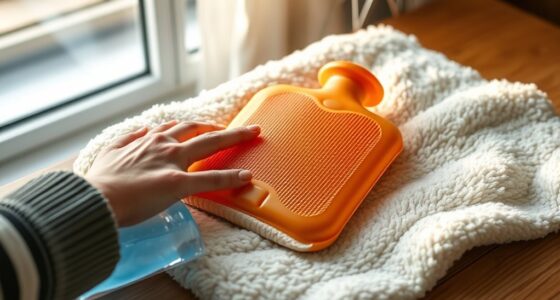Picture a tennis player tightly holding onto their racket, sensing their fingers tightening with every forceful swing. Consider the ramifications arthritis could have on their performance in the game.
The intersection of arthritis and sports is a complex one, with challenges and considerations unique to athletes facing joint issues. How can athletes continue to excel in their sport while managing arthritis effectively?
Let's explore strategies and insights that can help athletes navigate this delicate balance between passion for sports and joint health.
Key Takeaways
- Sports improve joint flexibility and muscle support.
- Low-impact exercises enhance joint mobility.
- Mindfulness activities reduce stress and manage pain effectively.
- Flexibility and strength training are vital for arthritis management.
Benefits of Sports for Arthritis
Engaging in sports offers individuals with arthritis a multitude of benefits, ranging from improved joint flexibility to enhanced overall well-being. For those dealing with arthritis, physical therapy through sports can play a crucial role in managing pain and increasing mobility. Regular participation in sports activities can help strengthen the muscles around the joints, providing better support and stability, which is essential for individuals with arthritis. This added strength can alleviate some of the pressure on the joints, reducing discomfort and improving overall function.
Moreover, sports involvement can act as a form of pain management for arthritis. The endorphins released during physical activity can serve as natural pain relievers, offering relief from the symptoms associated with arthritis. By engaging in sports, individuals can experience a decrease in stiffness and an increase in joint mobility, leading to a better quality of life. Through the combination of physical therapy and pain management techniques, sports can be a valuable tool in managing arthritis effectively.
Types of Recommended Exercises

To effectively manage arthritis, incorporating a variety of recommended exercises into your routine is essential. These exercises, recommended by physical therapists, can play a significant role in improving joint health and reducing pain associated with arthritis.
Here are four types of recommended exercises:
- Low-Impact Activities: Engaging in low-impact exercises like swimming, cycling, or walking can help enhance joint flexibility and alleviate pain without putting excessive strain on the joints.
- Strength Training Exercises: Incorporating light weights or resistance bands into your workout routine can aid in building muscle around the joints, providing crucial support and stability for individuals with arthritis.
- Range of Motion Exercises: Gentle stretches and movements aimed at maintaining flexibility can help prevent stiffness in arthritic joints, promoting overall joint health.
- Balance Exercises: Activities such as standing on one leg or using a balance board can enhance stability, reduce the risk of falls, and improve coordination, all of which are beneficial for individuals with arthritis.
Tips for Managing Joint Pain
For individuals managing joint pain caused by arthritis, implementing effective strategies can significantly improve daily comfort and mobility. It's crucial to engage in low-impact exercises like swimming and biking, which can help strengthen muscles surrounding the joints without putting excessive stress on them. Maintaining a healthy weight is also essential, as it reduces the burden on joints, thereby easing discomfort and enhancing mobility. Including anti-inflammatory foods such as fatty fish, nuts, and berries in your diet can help alleviate joint inflammation and promote overall joint health. Additionally, applying heat or cold therapy to affected joints can offer relief from pain and stiffness. Mindfulness practices like yoga and meditation are beneficial for reducing stress levels, which can worsen joint pain. Remember, consulting orthopedic doctors for personalized advice and treatment plans is crucial, especially if the joint pain is due to sports-related injuries.
| Strategies | Benefits | Examples |
|---|---|---|
| Low-impact exercises | Strengthen muscles, reduce joint stress | Swimming, biking |
| Healthy weight management | Decrease joint burden, enhance mobility | Balanced diet |
| Anti-inflammatory foods | Alleviate joint inflammation, promote joint health | Fatty fish, nuts, berries |
| Heat/Cold therapy | Provide pain relief, reduce stiffness | Heating pads, ice packs |
Precautions for Active Individuals

What precautions should active individuals take to protect themselves from developing arthritis and promote long-term joint health? Here are some key steps to consider:
- Ensure Accurate Diagnosis: It's crucial for active individuals to seek an accurate diagnosis of any injuries or joint issues they may have. Consulting with sports medicine specialists can help in understanding the root causes of pain and developing a targeted treatment plan.
- Address Muscular Imbalances: Active individuals should focus on addressing any muscular imbalances through targeted exercises and stretches. This can help in reducing the strain on joints and lowering the risk of arthritis development.
- Seek Guidance from Sports Medicine Professionals: Working closely with sports medicine professionals can provide valuable insights into injury prevention techniques and proper training methods. These experts can offer personalized advice to help minimize the risk of arthritis.
- Follow Proper Rehabilitation Protocols: It's essential for active individuals to follow proper rehabilitation protocols after injuries. This includes complete healing before returning to physical activity to prevent long-term joint damage and reduce the likelihood of arthritis.
Importance of Flexibility and Strength
Addressing the importance of flexibility and strength in athletic pursuits is paramount for preventing injuries and managing conditions like arthritis. Flexibility training plays a crucial role in reducing joint stiffness and increasing range of motion, particularly beneficial for athletes with arthritis. It helps in maintaining joint health and function, ultimately enhancing performance.
On the other hand, strength exercises are essential for providing support and stability to the muscles around affected joints, leading to a decrease in pain and an improvement in overall athletic abilities. By incorporating regular flexibility and strength exercises into a tailored program, athletes can optimize their performance while minimizing the symptoms of arthritis.
Balancing these two aspects in training not only aids in injury prevention but also contributes to better management of arthritis. Remember, a combination of flexibility and strength training is key to ensuring longevity in sports and effectively coping with conditions like arthritis.
Frequently Asked Questions
Is It OK to Play Sports With Arthritis?
Yes, it's possible to play sports with arthritis. Proper management and guidance from healthcare professionals are crucial. Monitoring symptoms and adjusting activity levels can help prevent flare-ups. Modifications, like using proper equipment, are essential to reduce joint stress.
Consulting a sports medicine specialist can create a tailored plan for safe participation. Low-impact sports such as swimming, cycling, or walking can be beneficial. Remember, it's about finding what works best for you.
How Do Athletes Deal With Arthritis?
Dealing with arthritis can be challenging for athletes, but through dedication and proper management, we can overcome these obstacles. By incorporating fitness maintenance and low-impact exercises, along with pain management techniques like OTC pain relievers and physical therapy, we can effectively cope with arthritis symptoms.
It's crucial to prioritize complete healing of sports injuries before returning to activity to reduce arthritis risk. Seeking guidance from sports medicine professionals and addressing muscular imbalances can also help prevent arthritis development.
How Do You Stop Arthritis From Getting Worse?
To stop arthritis from getting worse, we focus on maintaining joint flexibility, strengthening supporting muscles, managing weight, and following an anti-inflammatory diet.
By engaging in low-impact exercises, avoiding high-impact activities, and seeking guidance from healthcare professionals, we can create personalized plans to address our specific needs and conditions.
Taking proactive steps to reduce joint stress and inflammation can help manage symptoms and prevent arthritis progression.
Can You Live a Pain Free Life With Arthritis?
Absolutely, we can live a pain-free life with arthritis by diligently following a personalized treatment plan. With a combination of medication, physical therapy, lifestyle adjustments, and possible surgical interventions, arthritis pain can be significantly reduced, allowing us to maintain an active and fulfilling lifestyle.
Early diagnosis and proactive management are key in preventing further joint damage and ensuring a higher quality of life for individuals dealing with arthritis.
Conclusion
In conclusion, sports can be a powerful tool for managing arthritis and improving quality of life. Did you know that regular exercise can reduce arthritis pain by up to 40%?
By staying active, incorporating recommended exercises, and following proper precautions, individuals can strengthen their muscles, increase flexibility, and alleviate joint pain. Remember, movement is key to thriving with arthritis and staying active for years to come.









